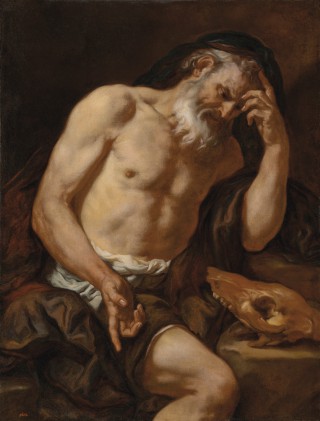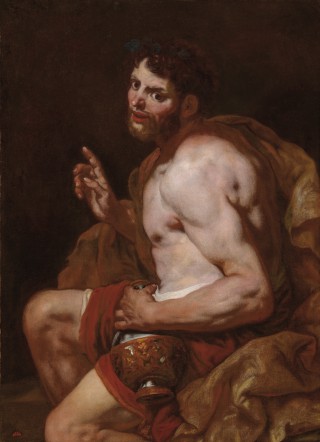Heraclitus
- Date
- 2nd half of the 17th c.
- Object type
- painting
- Technique
- oil
- Material
- canvas
- Dimensions
- 118,3 x 90,0 cm
- Acquisition date
- 1793
- Location
- The Palace on the Isle - Portrait Room, ground floor
- Marks and inscriptions
- red number 1659 of the Stanisław August collection, bottom left
- Place of Origin
- Venice (Italy)
- Owner
- The Royal Łazienki
- Museum number
- ŁKr 862
… Gerhard Ewald (Johann Carl Loth 1632–1698, Amsterdam 1965, nos. 535 and 538) described the Łazienki paintings [Heraclitus and Democritus] as allegorical representations of the Vanitas theme and emphasized their very close similarity to a pair of paintings in the Hermitage in St Petersburg entitled Melancholy… and Bacchus … .
The juxtaposition, based on contrasts between the lives and character—as well as the philosophical doctrines—of Heraclitus and Democritus went back as far as antiquity … .
In painting, the image of a ‘weeping philosopher’—Heraclitus—and a ‘laughing philosopher’—Democritus—was a recognizable allegory of the dual disposition of human nature, with pessimism and melancholy on one hand, and optimism and sanguinity on the other. This meaning was emphasized by the attributes, e.g. a globe of the Earth next to Heraclitus and a globe of the Heavens near Democritus … , or, as in our paintings, a gesture pointing to the earth or to heaven, and the inclusion of objects clearly associated with the vanitas theme, such as a horse’s skull and a wine jug.
The similarity between the paintings in the Hermitage to those in the Łazienki relates not only to their iconography, but also to the composition of one of the pair—Heraclitus— which is identical in almost every detail (only the arrangement of the left hand and the depiction of the skull differ slightly); whether the St Petersburg painting is an autograph replica of that in the Łazienki, or the other way round—cannot be determined. In the case of Democritus the differences between the Łazienki and Hermitage paintings are significant enough to consider them two various portrayals of the same subject. In our painting, Democritus, shown as a young man with a decorative wine jug, looks at the viewer with what is neither a smirk nor a smile and makes a gesture with his hand pointing upwards as if arguing that the values of life should be pleasure and harmony. In the St Petersburg painting, the young thinker is deep in contemplative meditation of the vase he is holding with both hands. He does not look at the viewer and does not point towards the heavens. [D. Juszczak, H. Małachowicz, The Stanisław August Collection of Paintings at the Royal Łazienki. Catalogue, Royal Łazienki Museum, Warsaw 2016, no. 65, pp. 250–252.]






